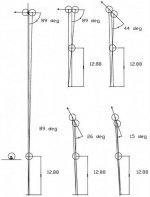This aiming method assumes one knows where the contact point on the equator of the OB that sends the OB to the pocket/target.
Starting with the center of the CB aimed at the contact point on the OB (CTCP) alignment.
Then lateral/parallel shift the shaft from the CB center to the OB center without regard to the CB (pretend that it isn’t there).
Pivot the tip of the cue from the bridge (hand) back to the center of the CB and shoot.
Again:
1 With the bridge hand about 12” - 13” behind the CB, Look for the contact/impact point on the OB equator that sends the OB to the target/pocket. – the point where the line from the center of the pocket /target exits the OB (near you).
2 Aim the cue/shaft from the center of the CB on a line to that point.
3 Ignoring the CB for now, lateral/parallel shift the cue until it is now pointing at the center of the OB
4 Pivot from that new cue and bridge location back to the center of the CB – shoot.
The shift from the contact point (CT) to the center of the OB will change as the distance between the CB and OB changes – larger shift when the CB is close to the OB and a smaller shift when the CB and OB are farther apart.
This is because perspective makes the OB ball appear to be a smaller diameter as it is moved father (down table) away from CB and the eye. This will change the included angle of the pivot – a large included angle when the OB is close and appears to be just a bit smaller circle than the CB and a smaller included angle when the OB is farther away and appears to be an even smaller circle.
What this does is to double the distance and included angle from the contact point (CP) to the center of the OB to send the CB to the location of the Ghost Ball (GB). The shift moves the bridge hand/cue to the side of the center of the CB. The pivot back to the center of the CB creates a aimilar included angle to the outside of the CP on the OB by that same distance, thus doubling the distance of the final aim. If you know double distance aiming, you can check the new final aim line….to the GB.
This changing of the shift from a large shift when the CB and OB are close together and smaller shift when the CB and OB are farther apart, prevents the CB from missing the cut angle to the outside of the GB resulting in a thinner cut and eventually missing contact with the OB to the outside.


Starting with the center of the CB aimed at the contact point on the OB (CTCP) alignment.
Then lateral/parallel shift the shaft from the CB center to the OB center without regard to the CB (pretend that it isn’t there).
Pivot the tip of the cue from the bridge (hand) back to the center of the CB and shoot.
Again:
1 With the bridge hand about 12” - 13” behind the CB, Look for the contact/impact point on the OB equator that sends the OB to the target/pocket. – the point where the line from the center of the pocket /target exits the OB (near you).
2 Aim the cue/shaft from the center of the CB on a line to that point.
3 Ignoring the CB for now, lateral/parallel shift the cue until it is now pointing at the center of the OB
4 Pivot from that new cue and bridge location back to the center of the CB – shoot.
The shift from the contact point (CT) to the center of the OB will change as the distance between the CB and OB changes – larger shift when the CB is close to the OB and a smaller shift when the CB and OB are farther apart.
This is because perspective makes the OB ball appear to be a smaller diameter as it is moved father (down table) away from CB and the eye. This will change the included angle of the pivot – a large included angle when the OB is close and appears to be just a bit smaller circle than the CB and a smaller included angle when the OB is farther away and appears to be an even smaller circle.
What this does is to double the distance and included angle from the contact point (CP) to the center of the OB to send the CB to the location of the Ghost Ball (GB). The shift moves the bridge hand/cue to the side of the center of the CB. The pivot back to the center of the CB creates a aimilar included angle to the outside of the CP on the OB by that same distance, thus doubling the distance of the final aim. If you know double distance aiming, you can check the new final aim line….to the GB.
This changing of the shift from a large shift when the CB and OB are close together and smaller shift when the CB and OB are farther apart, prevents the CB from missing the cut angle to the outside of the GB resulting in a thinner cut and eventually missing contact with the OB to the outside.


Last edited: